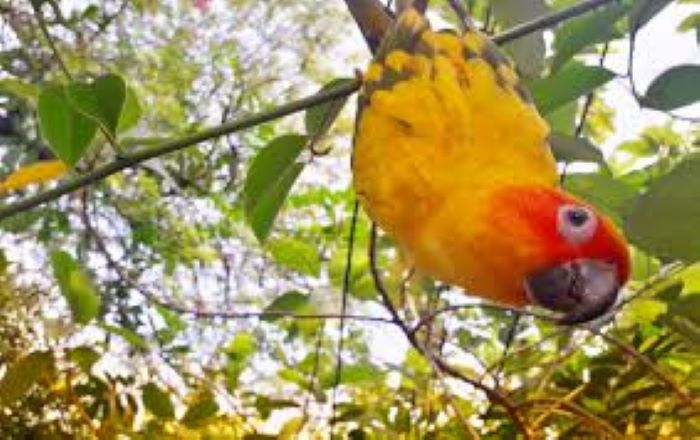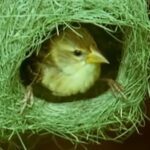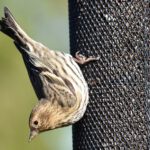Aspergillosis is a common and very serious fungal infection that affects the respiratory system of parrots. It is caused by the Aspergillus fungus, a mold that is found almost everywhere in the environment. Aspergillosis can occur in any species of parrot, though some may be more susceptible than others. If left untreated, aspergillosis can be fatal. In this article we talk about Aspergillosis in Parrots.
What Causes Aspergillosis in Parrots?

Aspergillus spores are present in the air we breathe, in the soil, and on decaying vegetation. Healthy parrots are usually able to fight off low levels of exposure. However, when a parrot’s immune system is compromised or under stress, the bird becomes vulnerable to developing an Aspergillus infection.
Predisposing factors include:
- Poor diet and malnutrition
- Chronic stress
- Overcrowding and poor hygiene
- Concurrent infections or diseases
- Inhaling large amounts of fungal spores
Once inside the body, the fungus begins to grow, forming masses of fungal material called granulomas. These can block the airways and damage lung tissue.
Symptoms of Aspergillosis
Unfortunately, symptoms of aspergillosis usually do not appear until the infection has progressed. Since the respiratory system is impacted, some of the most common signs include:
- Labored or rapid breathing
- Clicking or wheezing sounds
- Loss of voice
- Discharge from nares or beak
- Sneezing and head shaking
- Loss of appetite and weight loss
In later stages, infected birds may exhibit depression, weakness, diarrhea, vomiting, and seizures. Sudden death can occur.
Because symptoms take a while to manifest, or may resemble other less serious respiratory issues, aspergillosis often goes undetected until the infection has advanced. That’s why avian veterinarians recommend routine testing for at-risk birds.
Diagnosing Aspergillosis
To diagnose aspergillosis, veterinarians will begin with a complete history and physical exam, looking for clinical signs associated with the disease. Diagnostic tests may include:
Blood tests to check for antibodies and to assess organ function. Changes can indicate an active Aspergillus infection. Radiographs (x-rays) to identify masses or lesions in the lungs and air sacs. Telltale signs of fungal growth may be visible. CT scans for a more detailed view of the lungs and respiratory system. Endoscopy to examine the airways. Tissue or fluid samples may also be collected. Fungal culture to identify Aspergillus organisms in the samples collected.
A combination of tests is usually needed to confirm diagnosis, determine the type of aspergillosis present, and design the most effective treatment plan.
Types of Aspergillosis
There are three main types of aspergillosis seen in parrots:
- Tracheal/Bronchial Form: Fungal plaques grow in the trachea, primary and secondary bronchi. This can cause airway obstruction.
- Pulmonary Form: Masses or granulomas develop inside lung tissue, damaging function.
- Air Sac Form: Infection and inflammation of the air sacs. This can spread to other sites like the coelom (body cavity).
The type of aspergillosis has implications for treatment approach and prognosis. In general, the tracheal/bronchial form has the best outlook with aggressive therapy, while the other two types are more challenging to cure.
Treating Aspergillosis
Treatment is aimed at eliminating the fungal infection, relieving symptoms, and preventing progression. Since Aspergillus has the ability to encyst itself and go dormant, long-term treatment is usually required. Options may include:
- Antifungal medication, given orally or by nebulization/inhalation. Itraconazole and voriconazole are common choices. Treatment duration is often several months.
- Draining abscesses or flushing air sacs to remove fungal debris.
- Surgery to remove masses or granulomas in some cases.
- Supportive care such as fluids, nutritional support, and nebulization to ease breathing.
Hospitalization in an incubator may be required for birds who are extremely ill. Response to treatment is monitored with repeat testing and evaluations. Treatment may continue even after clinical signs resolve to prevent recurrence.
Preventing Aspergillosis in Parrots
While aspergillosis can never be fully prevented since fungal spores are ubiquitous in the environment, bird owners can reduce risk by:
- Feeding a balanced, species-appropriate diet
- Minimizing stress
- Avoiding overcrowding and poor sanitation
- Performing routine health exams to catch issues early
- Having new birds tested for aspergillosis prior to introducing them
- Using air purification systems when possible
- Avoiding construction, demolition, or other dust-producing activities
By supporting immune health and reducing exposure, parrots can better resist opportunistic Aspergillus infections. But since this fungus is so prevalent in nature, vigilance is still required. Know the signs of aspergillosis and seek prompt veterinary care at any suspicion of respiratory disease. Aggressive treatment greatly improves survivability – and prevents spreading infection to other vulnerable birds in the flock.
With attentive care and preventative steps, parrots can continue thriving for years to come despite the silent threat of aspergillosis. I sincerely hope you find this “Aspergillosis in Parrots-A Silent Threat” article helpful.
If you enjoyed this article, you might also read this: What is the Average Wingspan of a Seagull?

Stina is the expert behind BirdFacts.net, dedicated to sharing her passion and knowledge about birds. With a degree in Environmental Science and over 6 years of birdwatching experience, she brings both expertise and enthusiasm to her writing. Stina’s work aims to inspire appreciation for birds and promote responsible birdwatching. Follow her bird-filled journey on Instagram.





